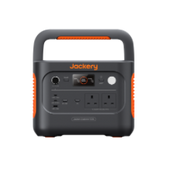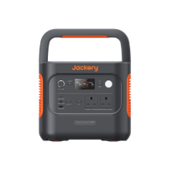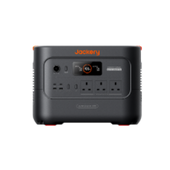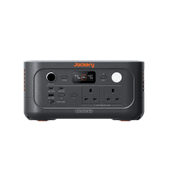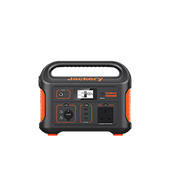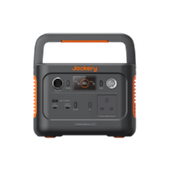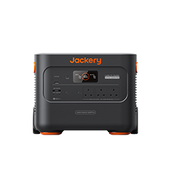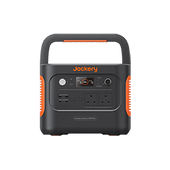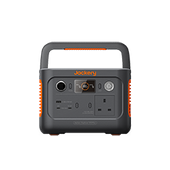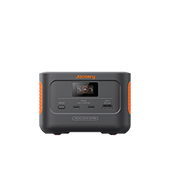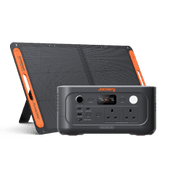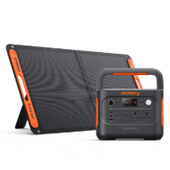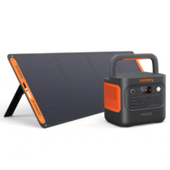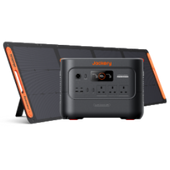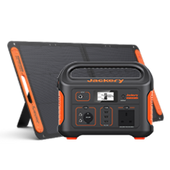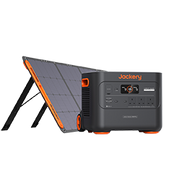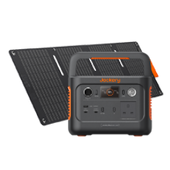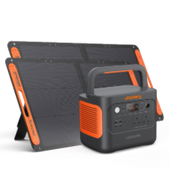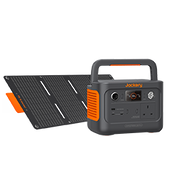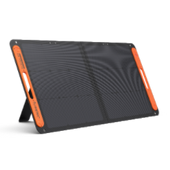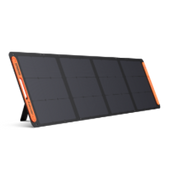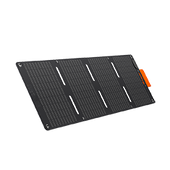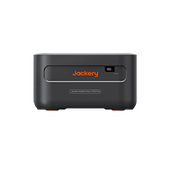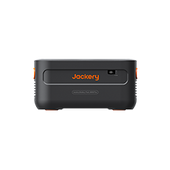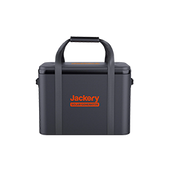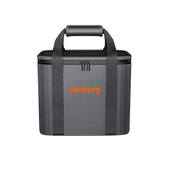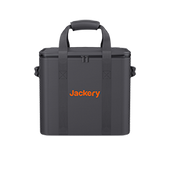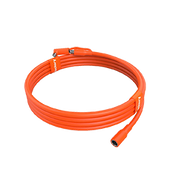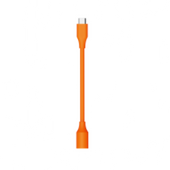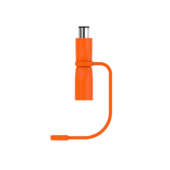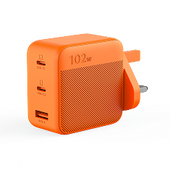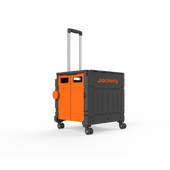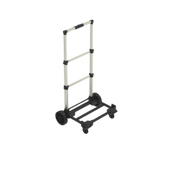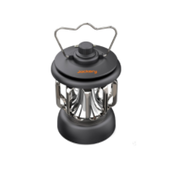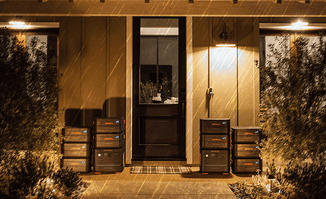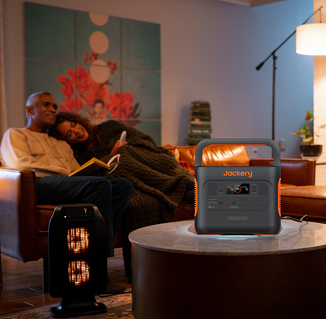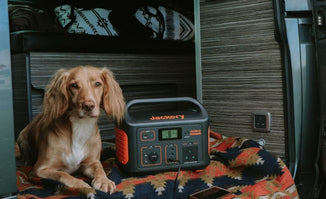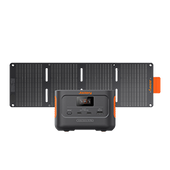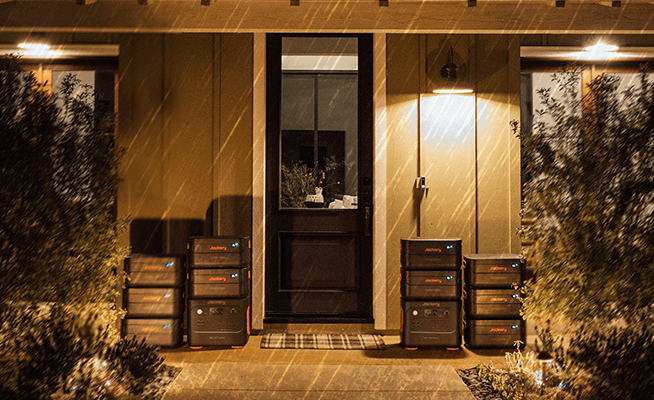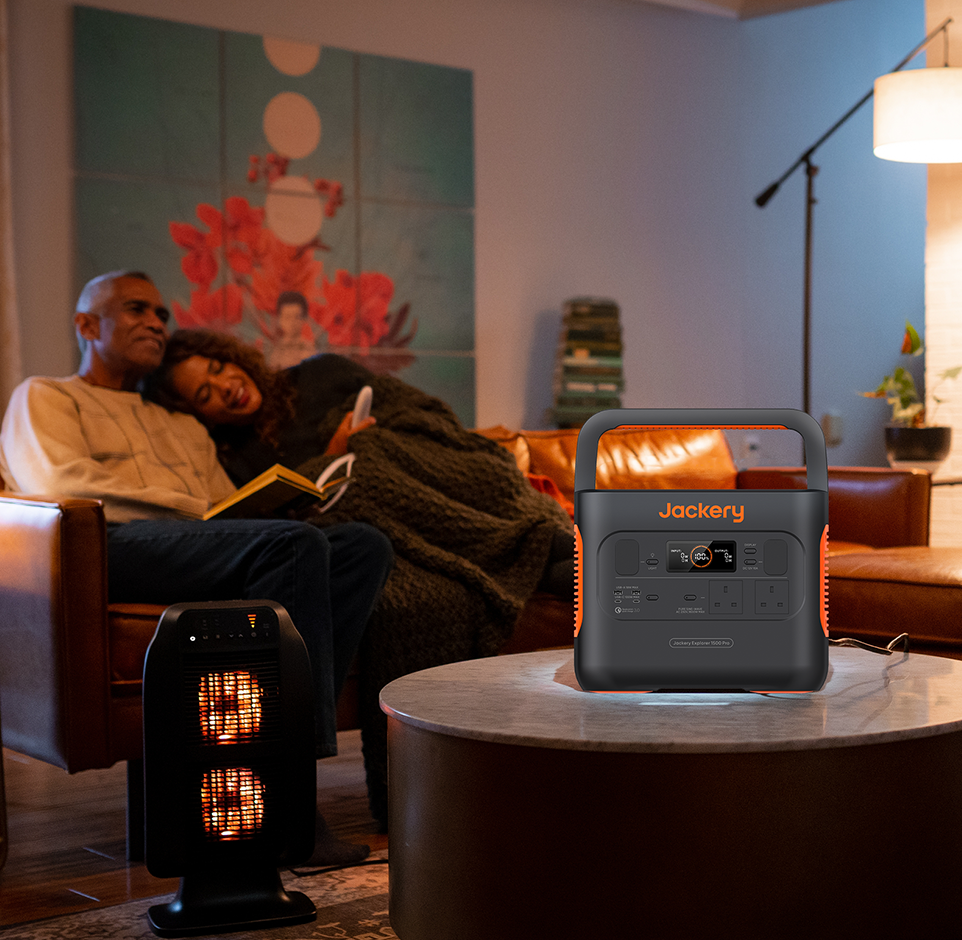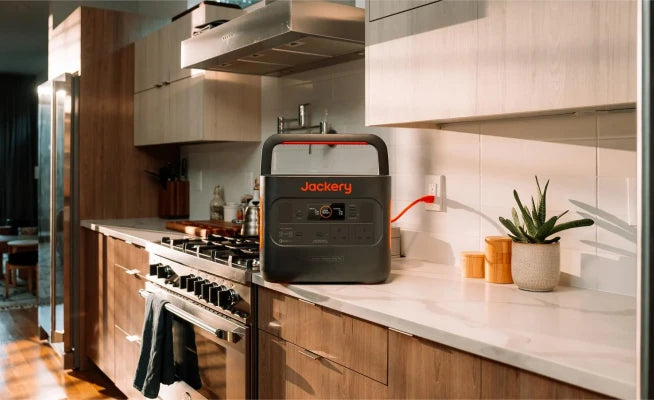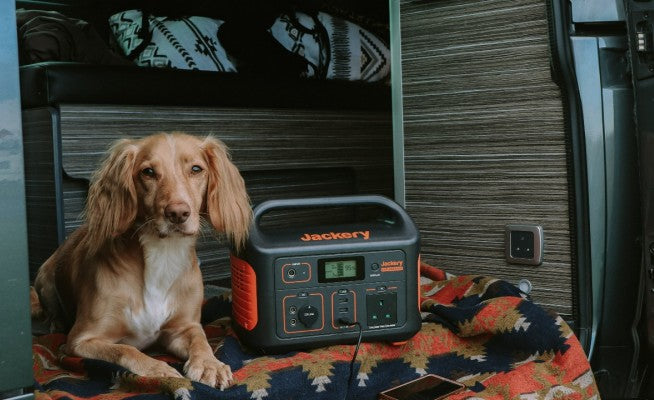Solar Powered Fan VS. Solar Generator for Fan
Maintaining a cool residence during the summer is essential. When many people consider comfort during the hot days and evenings of summer, they consider keeping effective air conditioning. A solar-powered fan can make most residences more comfortable by removing excess heat and reducing energy costs.

For example, a standard ceiling fan requires 50W to operate. Powerful fans can be expensive to run. The average fan wattage on high is 39.3W, and on low, it is 6.8W. The average fan wattage is 33W. Also, 220W was the highest fan wattage documented in the study.
This page describes what a solar-powered fan is, how it works, and the comparisons between a solar-powered fan and a solar generator for a fan. For charging your fans and other home appliances, we recommend Jackery solar generators, specifically the Solar Generator 240 with 240Wh capacity, which is clean, quiet, and affordable.
 |
|
|
- 240Wh capacity and lithium-ion battery - 200W rated power and 400W surge power - High conversion efficiency of up to 24.3% - 2*USB ports, AC outlet, and 12V car output - Reasonable price |
What is A Solar Powered Fan
Camping, living off the grid, and working in the greenhouse or workshop are situations where a fan is desirable, but there is no nearby electrical receptacle. Solar-powered fans come in various sizes and designs, but they all utilize the sun's energy to provide a cool breeze on hot days. Small fans are designed to be carried on summer excursions, and large ones are intended for installation on the roof to chill large rooms or attic.
Your choice of a solar-powered fan will depend on where you intend to use it. There are a variety of portable fans that can be used while camping, walking, or reclining by the pool if you are seeking a personal fan.
Alternatively, there is a considerable size of solar-powered fans designed to cool entire rooms in structures. These fans typically specify the square footage they cover and the airflow they generate in cubic feet per minute.
How Does A Solar Powered Fan Work
Similar to conventional fans, rechargeable solar fans function similarly. Solar panels are utilized to generate electricity. Solar energy is transformed into electricity by using solar panels. Even though some solar fans are equipped with a rechargeable battery, many are powered solely by DC energy generated by the solar panel.
Solar panels charge the fan's batteries, which power the fan. If the batteries are not fully charged, the fan may rotate more slowly or cease working entirely. It is, therefore, essential to position the solar panel in a location where it will receive ample sunlight.
How Many Watts Does A Fan Use

For example, a standard ceiling fan requires 50 Watts to operate. Powerful fans can be expensive to run. The average fan wattage on high is 39.3W, and on low, it is 6.8W. The average fan wattage is 33W. 220W was the highest fan wattage documented in the study. The minimum power consumption was 1.1W.
Different fans consume varying amounts of energy and offer varying degrees of efficiency. The ceiling fan has the lowest operating wattage, followed by the upright and tower fans. Box fans have the most excellent maximum average wattage. Nevertheless, they are larger and move more air than standing and tower fans.
|
Types |
Low Wattage Average |
Max Wattage Average |
Common Wattage |
Lowest Wattage |
Highest Wattage |
|
All |
7W |
39W |
33W |
1.1W |
220W |
|
Ceiling Fan |
4W |
31W |
33W |
1.7W |
100W |
|
Tower Fan |
44W |
56W |
54W |
6W |
110W |
|
Box Fan |
47W |
73W |
100W |
5W |
220W |
|
Table Fan |
17W |
43W |
40W |
1.1W |
110W |
How Much Solar Power Does A Fan Need
A kWh is a unit of measurement for electricity, also known as a unit of electricity. A kWh represents the number of kilowatts consumed over time. At high speeds, a fan's average hourly electricity consumption is 0.0393 kWh, while at moderate rates, the average consumption is 0.0069 kWh.
|
Grills |
Watts |
Length of Use |
Solar Power Needed |
|
Average |
7W-40W |
8H |
56kWh-320kWh |
|
Ceiling Fan |
4W-31W |
8H |
32kWh-248kWh |
|
Tower Fan |
44W-56W |
8H |
352kWh-448kWh |
|
Box Fan |
47W-73W |
8H |
376kWh-584kWh |
|
Table Fan |
17W-43W |
8H |
136kWh-344kWh |
Jackery Solar Generators for Fans
Solar fans are a necessity that makes the oppressive summer heat somewhat bearable. Today, there are various types, sizes, and styles of fans. These cooling systems play a crucial role in circulating the air within the room, allowing for the introduction of cool air instead of hot air.
As a solar-powered fan, also known as solar panels for fans, is highly dependent on direct sunlight, location, and angle of solar panels, it makes more sense to charge your fans with a portable solar generator now.
Jackery is the most preferred solar brand that offers a variety of superior solar products, such as solar generators, solar panels, and power stations. SolarSaga solar panels and Explorer power stations are combined to form Jackery solar generators. The solar panels convert sunlight into electricity, and the power station can store energy, allowing the Jackery solar generators to be used at any time and location. In contrast, solar-powered fans may only operate when there is direct sunlight.

In addition, a Jackery solar generator can help you save money on utility bills, as this energy generation system uses only sunlight to generate electricity and is, therefore, completely free. Install your system in a location that receives ample sunlight and activate the power button.
Jackery solar generators can power solar fans and other fans and appliances. The Solar Generator 240 requires only 29 to 5.1 hours to power wattage devices with a capacity of 240Wh, such as a fan that consumes between 7 and 40 Watts on average. This portable solar generator is suitable for outdoor activities such as tent camping, road trips, backyard camping, etc., because it weighs only 6.6 pounds and has a solid handle that makes it simple to transport. Bring only your camping supplies and this portable solar generator on your next camping trip.
|
Series |
Capacity |
Ports |
Fan Watts |
Working Hours |
|
Jackery Solar Generator 240 |
240Wh |
AC Output: 110V, 60Hz, 200W (400W Peak) 2*USB-A Output: 5V, 2.4A Car Port: 12V, 10A |
Average: 7W-40W Ceiling Fan: 4W-31W Tower Fan: 44W-56W Box Fan: 47W-73W Table Fan: 17W-43W |
Average: 29H-5.1H Ceiling Fan: 51H-6.6H Tower Fan: 4.6H-3.6H Box Fan: 4.3H-2.8H Table Fan: 12H-4.7H |
Except for the Solar Generator 240, the Solar Generator 500 is more potent and can charge more devices simultaneously due to its higher 518Wh capacity. Solar Generator 500 can power standard fans for 62.9 and 11 hours, ceiling fans for 100 and 14.2 hours, and table fans for 25.9 and 10.2 hours. It incorporates SolarSaga 100W solar panels and an Explorer 500 power station. The Explorer 500 portable power station is constructed with a lithium-ion battery pack and a frame structure designed for safety to maximize and extend the power for all outdoor activities and domestic use.
|
Series |
Capacity |
Ports |
Fan Watts |
Working Hours |
|
Jackery Solar Generator 500 |
518Wh |
AC Output: 110V, 60Hz, 500W (1000W Peak) 3*USB-A Output: 5V, 2.4A DC Output: 12V, 10A Car Port: 12V, 10A |
Average: 7W-40W Ceiling Fan: 4W-31W Tower Fan: 44W-56W Box Fan: 47W-73W Table Fan: 17W-43W |
Average: 62.9H-11H Ceiling Fan: 100H-14.2H Tower Fan: 10H-7.9H Box Fan: 9.4H-6H Table Fan: 25.9H-10.2H |
Solar Powered Fan VS. Solar Generator for Fan
Despite the presence of air conditioners, fans continue to play a significant role in the summer conditioning systems of homes. Your choice of the solar-powered fan will depend on where you intend to use it. If you're looking for a personal fan, you can choose from various compact models that are typically lightweight and portable but only chill one or two people.
With a fan of this size, you must consider its installation requirements, how far away the solar panel can be mounted from the fan, and how it is controlled. Remember that some solar-powered fans lack built-in batteries and cannot operate at night.
However, a portable solar generator can solve all the issues solar enthusiasts face. Solar generators, for instance, are not limited by direct sunlight, time, location, or even the angle of solar panels, as it is sufficient to bury solar panels in the ground to convert sunlight into electricity for the power station. Also, with a solar generator pack, there is no need to locate the proper charge controller or inverter for solar panels, as these components are contained within the power station.
|
Types |
Pros |
Cons |
|
Solar Powered Fan |
- Keep your space cool - Reduce moisture - Green energy - Save electricity bills - Portability for some solar fans - Keep away the bugs |
- Pricey - Need more than one fan for some home - Require direct sunlight - Have restrictions on location, weather, and angle - Need proper charge controller, inverter, and battery - Need proper cable to connect the solar fans and cool you |
|
Solar Generator for Fan |
- Green energy - Easy to setup - No installation & maintenance - No restriction on weather, location, and angle - Cost-effective - Bundle with solar panels and power station - Not only power fans but most appliances indoor & outdoor - Portability |
- Some solar generators with large capacities may cost a little (but are cheaper than some solar fans) |
Solar Powered Fan
Solar panels charge the fan's batteries, which power the fan. If the batteries are not fully charged, the fan may rotate more slowly or cease working entirely. It is, therefore, essential to position the solar panel in a location where it will receive ample sunlight.
Those who live in areas with frequent cloudy days and those whose residences are shaded by trees should consider purchasing a solar-powered fan with a backup power source so they can continue to use the fan on cloudy days. If not, you will need a conventional electric fan as a backup. When selecting a solar-powered fan, it's imperative first to determine where the solar panel will receive the most sunlight, followed by the fan's location.
Pros:
- Solar fans can help keep your home fresh. In warmer climates, such as Florida, the heat accumulation in your attic can cause damage to your roof, insulation, and home's structural integrity.
- The humidity and moisture of summer can promote the development of fungi and molds in your attic while also causing damage to your home's structural supports.
- Solar fans benefit the environment by harnessing solar energy without electricity. Your solar attic fan as renewable energy will help you save money and reduce your carbon footprint.
- Solar power, also known as photovoltaic power, is used by the solar fan and is free and can also help reduce your utility expenses by expelling hot air from your fan.
Cons:
- Solar fans are relatively new and more expensive than conventional fans.
- In most homes, two solar attic fans are required to circulate the necessary air and increase energy savings.
- Solar fans require direct sunlight, as the sun is their energy source.
- Some solar fans require a charge controller, an inverter, and a battery to be used at night.
- An appropriate cable is required to connect you to your solar fans. Because a too-long cord could present a stumbling hazard, it is ideal for keeping them relatively close together.
- Solar attic fans are gaining popularity, but solar ceiling fans and window fans still need to be available.
Solar Generator for Fan
A portable solar generator is more suitable for powering a fan anywhere than solar fans, which require direct sunlight, the appropriate cables, and charge controllers. Solar generators are rechargeable batteries that are powered by solar panels. A solar generator consists of a rechargeable battery, an inverter, a solar panel, and a solar charger. Energy is extracted from the solar panel and transferred to the battery via the charger.
Solar generators have more benefits than solar fans and can power fans and most of your appliances. Jackery solar generators are your finest option for charging devices indoors and outdoors. Due to their portability and low weight, they can be taken on any outdoor excursion.

Solar generators not only produce reliable, pure electricity from the sun, but they also reduce greenhouse gas emissions. Solar generators come in various sizes and configurations, so selecting one that meets your requirements should be your top priority. As stated, you can choose between the Jackery Solar Generator 500 and 240 to power your fans.
Pros:
- Solar generators do not emit any harmful byproducts during operation. They are a source of renewable energy
- A solar generator never requires the replacement of ignition plugs, air filters, or fuel switches.
- Using a solar generator with solar panels eliminates the need to purchase fuel.
- Solar generators operate at near-silent noise levels.
- You can use a solar generator anytime to mitigate energy consumption.
- Solar generators reduce your carbon footprint and are environmentally friendly.
- Whether you are experiencing rolling blackouts or a power line is down in your area, you can use a solar generator as your source of electricity.
Cons:
Some solar generators with large capacities may be pricey but less expensive than solar fans. And they are economical over the long term.
Solar Powered Fan FAQs
These are the most commonly asked questions regarding solar-powered fans:
1. What size of solar generator do I need to power a fan?
When deciding how to power your fan with solar energy, it is crucial to calculate the wattage of your fan's energy consumption and select solar generators with the corresponding capacity. Typically, a fan consumes between 7W and 40W. Then, you can choose among all Jackery solar generators based on your requirements and budget.
How to determine how long the Jackery solar generator will require to charge your fan:
Working hours = solar generator capacity * 0.85 / your fan's wattage
Your 40W fan is powered by the 240Wh capacity Jackery Solar Generator 240. The number of equivalent work hours is 5.1 (240Wh*0.85/40W).
2. Do solar fans work at night?
When the sun sets, the solar fan shuts off because it is no longer powered by UV radiation and has no battery to store energy. However, when the fan is turned off, it still functions as a passive air vent. Therefore, your fan will continue to provide ventilation overnight. However, there are only solar panels and fans for some solar fans, so you must acquire an inverter, charge controller, and battery to use at night. A solar generator could be more beneficial than solar fans at that time.
Final Thoughts
The ideal solar-powered fan for you will depend on your needs. Someone interested in a portable fan for camping will have different needs than someone interested in cooling a large room or their entire house. However, a Jackery solar generator is recommended to power all fans, as it is not limited by direct sunlight, location, weather, or angle. Considering the drawbacks of solar fans, a portable solar generator seems more suited than solar fans.

